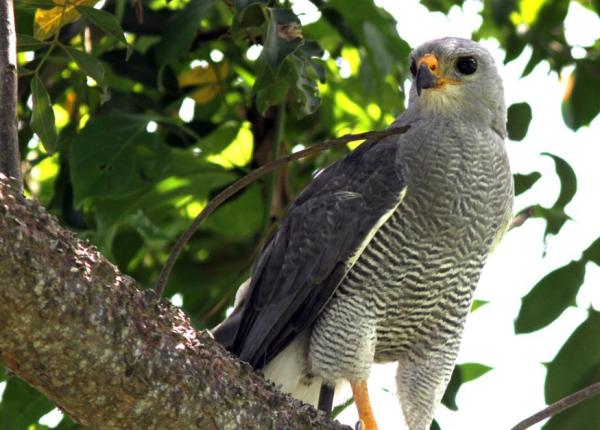Did You Know?
- This species was once known as the Mexican Goshawk
- The Gray Hawk has been split into two species: the Gray Hawk (Buteo plagiatus) and the Gray-lined Hawk (Buteo nitidus).
How The Peregrine Fund is Helping
Though The Peregrine Fund does not work directly with Gray Hawks, our efforts in scientific research, habitat conservation, education, and community development help conserve birds of prey around the world. We also supply literature to researchers from our avian research library, which helps scientists around the world gather and share important information on raptor conservation. Our work with the Neotropical Raptor Network helps conserve raptors by fostering collaboration and communication among raptor enthusiasts in the region. And, finally, our support of the Global Raptor Information Network gives raptor researchers tools to more efficiently conduct their own studies while contributing to a global program. It also provides citizen scientists a way to participate in raptor science and conservation.
Where They Live
The Gray Hawk is found from Costa Rica, north through Central America and Mexico and is found in the southern United States including Arizona and more rarely in New Mexico and Texas. This species makes its home in a number of different habitat types including riparian, woodlands, pine-oak forests, thorn forest, and more.
What They Do
The Gray Hawk is a diurnal bird of prey. This means it hunts, soars, and otherwise goes about its business during daylight hours, and roosts, or rests, at night. It is a beautiful hawk, with its plumage exhibiting various shades of grey. Its breast and belly is marked with dark gray horizontal barring. It has bright yellow legs and cere and dark eyes.
Why They Need our Help
The Gray Hawk is categorized as a species of Least Concern. Perhaps the biggest threat this species faces is loss and degradation of its habitat. One of the main sources of habitat degradation occurs in areas where groundwater is being depleted. When groundwater is used up, much of the above-ground gallery forests and riparian habitats begin to disappear.
What They Eat
The Gray Hawk feeds mostly on vertebrates, and seems to have a special affinity for reptiles, including Whiptail Lizard and Spiny Lizard. When hunting, it employs several different techniques, but mostly seems to sit and wait for unsuspecting prey to pass by. They also hunt by soaring.
Nests, Eggs, and Young
The Gray Hawk builds a relatively compact nest which they construct using twigs that are still covered in leaves. The male and female work together to build their nest, often collecting twigs and sticks from live trees. They use their feet and beaks to break off nesting material. Once the nest is built, the female will often line it with softer materials.
After the eggs are laid, the female is responsible for incubating them. She must do this for around 34 days - keeping her eggs safe and at just the right temperature so that the embryos grow into healthy chicks. During this time, the male is responsible for finding food for himself and the female. After hatching, the nestlings will grow quickly. After only 42 days they will be ready to fly from the nest for the first time.
Gray Hawk and the World Center for Birds of Prey
The World Center for Birds of Prey offers fun ways to learn about birds of prey. The visitor center offers interactive displays, tours, interesting videos and a children's room with activities from coloring sheets to quizzes to costumes and a touch table for the curious mind. We also have several different birds of prey on display year-around. Knowledgeable staff and volunteers are on hand to answer any questions you may have about Gray Hawks or any other birds of prey.
References:
Bibles, B. D., R. L. Glinski, and R. R. Johnson (2020). Gray Hawk (Buteo plagiatus), version 1.0. In Birds of the World (A. F. Poole and F. B. Gill, Editors). Cornell Lab of Ornithology, Ithaca, NY, USA. https://doi.org/10.2173/bow.gryhaw2.01
http://www.darwiniana.org/zoo/AOUb.html
Global Raptor Information Network. 2022. Species account: Gray Hawk Buteo plagiatus. Downloaded from http://www.globalraptors.org on 29 Mar. 2022










